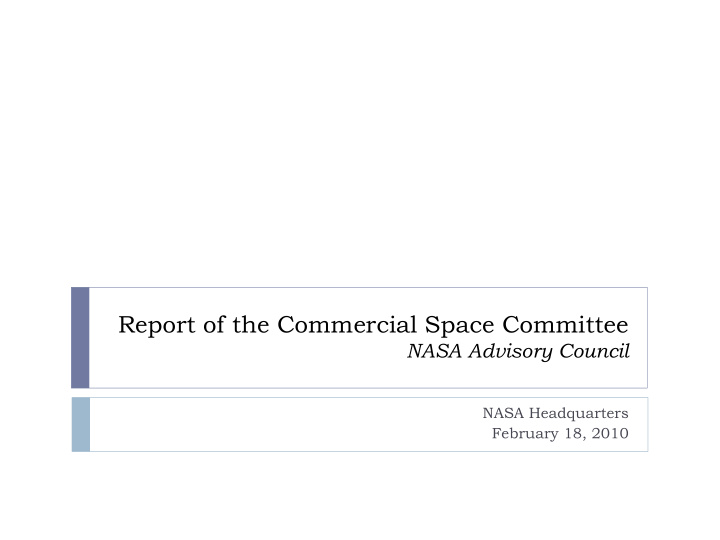



Report of the Commercial Space Committee NASA Advisory Council NASA Headquarters February 18, 2010
Commercial Committee Members Bretton Alexander, Chair President of the Commercial Spaceflight Federation Maj Gen Donald Hard (USAF, Ret.) Independent consultant to government and industry Bernard A. Harris, Jr., (M.D.) CEO of Vesalius Ventures, former NASA astronaut, and former SPACEHAB executive Lon Levin Co-founder of XM Satellite Radio and other satellite businesses J. Michael Lounge Former NASA astronaut and former Boeing executive Patti Grace Smith Former FAA Associate Administrator for Commercial Space Transportation and consultant/advisor to space and aerospace companies Wilbur C. Trafton Former NASA Associate Administrator for Space Flight and executive at ILS and Kistler Aerospace John Emond, Executive Secretary NASA Innovative Partnerships Program Office 2 Report of the NAC Commercial Space Committee (February 18, 2010)
Work Plan (Draft) Review and advise on how best to optimize NASA’s organizational elements 1. and address cultural issues to effectively encourage and promote the development of a commercial space industry. Review NASA’s strategy and plans for stimulating a commercial space 2. industry, and provide advice on effective and appropriate methods for NASA to stimulate, encourage and partner with commercial space. What is the logical progression for developing a commercial capability for transportation to ISS and LEO? Review and advise on NASA’s strategy for partnering and cooperating with 3. other federal agencies on commercial space. Provide advice on how NASA should define “commercial space” to 4. effectively implement “commercial space” programs and policies. 3 Report of the NAC Commercial Space Committee (February 18, 2010)
Meeting Schedule First meeting held Tuesday, February 16, 2010 Held at NASA Headquarters in Washington, DC Attendance 6 of 7 committee members present Approximately 25 members of the public and NASA attended Welcome by Deputy Administrator Lori Garver, as well as: Bill Gerstenmeier, Associate Administrator for Space Operations Doug Cooke, Associate Administrator for Exploration Systems Doug Comstock, Director of the Innovative Partnerships Program Office Next Meetings: Tuesday, March 30 in Washington, DC Monday, April 26 in Houston, TX 4 Report of the NAC Commercial Space Committee (February 18, 2010)
Presentations to the Committee Overview of NASA’s Commercial Space Efforts (Doug Comstock, Director IPP) What is commercial space? Seed Fund Partnerships Licensing Service Purchases Facilitated Access to the Space Environment for Technology Development and Training (FAST) Commercial Reusable Suborbital Research (CRuSR) Program Centennial Challenges Commercial Reusable Launch Vehicle Technology Roadmap Study Commercial and Government Responsive Access to Space Technology Exchange (CRASTE) Commercial Reusable Suborbital Research (CRuSR) and a Potential NASA Strategy for achieving Low-Cost and Reliable Access to Space (LCRATS) (Charles Miller, IPP) Historical attempts at achieving low-cost reliable access to space Historical lessons on development of the airplane and establishment of NACA NACA approach for low-cost reliable access to space Commercial and Government Responsive Access to Space Technology Exchange (CRASTE) Commercial Reusable Launch Vehicle Technology Roadmap Study 5 Commercial Reusable Suborbital Research (CRuSR) program and activities
Presentations to the Committee (cont.) Commercial Cargo and Crew Overview (Geoff Yoder, ESMD) Commercial Crew and Cargo Program Commercial Orbital Transportation Services (COTS) Program Commercial Crew Development (CCDev) Program Integrated Approach for Commercial Crew Services Defining Human Rating Requirements for Commercial Crew International Space Station Status (Sam Scimemi, SOMD) ISS Today ISS Cargo and Crew Requirements Current Transportation Arrangements COTS and Commercial Resupply Services (CRS) Flights ISS Commercial Potential 6 Report of the NAC Commercial Space Committee (February 18, 2010)
Committee Discussion Priority on commercial crew and cargo programs given recent budget announcement Defining “commercial space” Attributes of commercial versus traditional government contracting Lessons learned from previous commercial space efforts Examples included SPACEHAB and Evolved Expendable Launch Vehicle (EELV) Next Steps Meeting schedule Briefings/information desired Findings / Observations / Recommendations 7 Report of the NAC Commercial Space Committee (February 18, 2010)
Committee Discussion (cont.) Commercial Attribute comparison and range: from traditional government ownership and control with unique requirements and custom product, to commercial model of company owned and designed, set price, pay for performance Attribute Traditional Govt Pure Commercial Space Example ↔ Product type One-of-a-kind Commodity gps receivers, “bespoke” “tailored” “off -the- rack” Comsats ↔ Customers NASA only Ability to serve multiple ↔ Design NASA-specified Company-specified comsats ↔ Owner/Operator NASA Company Shuttle vs EELV Delivery on orbit ↔ Contracting Cost-plus Firm-fixed price, Comsats pay-for-performance ↔ Price based on cost-plus Market-based ↔ Financing 100% NASA Private financing/ Customer payments ↔ Risk (perf, financial) NASA Company consumer gps 8 Report of the NAC Commercial Space Committee (February 18, 2010)
Recommend
More recommend